Intel SSD 520 Review: Cherryville Brings Reliability to SandForce
by Anand Lal Shimpi on February 6, 2012 11:00 AM ESTAnandTech Storage Bench 2011
Last year we introduced our AnandTech Storage Bench, a suite of benchmarks that took traces of real OS/application usage and played them back in a repeatable manner. I assembled the traces myself out of frustration with the majority of what we have today in terms of SSD benchmarks.
Although the AnandTech Storage Bench tests did a good job of characterizing SSD performance, they weren't stressful enough. All of the tests performed less than 10GB of reads/writes and typically involved only 4GB of writes specifically. That's not even enough exceed the spare area on most SSDs. Most canned SSD benchmarks don't even come close to writing a single gigabyte of data, but that doesn't mean that simply writing 4GB is acceptable.
Originally I kept the benchmarks short enough that they wouldn't be a burden to run (~30 minutes) but long enough that they were representative of what a power user might do with their system.
Not too long ago I tweeted that I had created what I referred to as the Mother of All SSD Benchmarks (MOASB). Rather than only writing 4GB of data to the drive, this benchmark writes 106.32GB. It's the load you'd put on a drive after nearly two weeks of constant usage. And it takes a *long* time to run.
1) The MOASB, officially called AnandTech Storage Bench 2011 - Heavy Workload, mainly focuses on the times when your I/O activity is the highest. There is a lot of downloading and application installing that happens during the course of this test. My thinking was that it's during application installs, file copies, downloading and multitasking with all of this that you can really notice performance differences between drives.
2) I tried to cover as many bases as possible with the software I incorporated into this test. There's a lot of photo editing in Photoshop, HTML editing in Dreamweaver, web browsing, game playing/level loading (Starcraft II & WoW are both a part of the test) as well as general use stuff (application installing, virus scanning). I included a large amount of email downloading, document creation and editing as well. To top it all off I even use Visual Studio 2008 to build Chromium during the test.
The test has 2,168,893 read operations and 1,783,447 write operations. The IO breakdown is as follows:
| AnandTech Storage Bench 2011 - Heavy Workload IO Breakdown | ||||
| IO Size | % of Total | |||
| 4KB | 28% | |||
| 16KB | 10% | |||
| 32KB | 10% | |||
| 64KB | 4% | |||
Only 42% of all operations are sequential, the rest range from pseudo to fully random (with most falling in the pseudo-random category). Average queue depth is 4.625 IOs, with 59% of operations taking place in an IO queue of 1.
Many of you have asked for a better way to really characterize performance. Simply looking at IOPS doesn't really say much. As a result I'm going to be presenting Storage Bench 2011 data in a slightly different way. We'll have performance represented as Average MB/s, with higher numbers being better. At the same time I'll be reporting how long the SSD was busy while running this test. These disk busy graphs will show you exactly how much time was shaved off by using a faster drive vs. a slower one during the course of this test. Finally, I will also break out performance into reads, writes and combined. The reason I do this is to help balance out the fact that this test is unusually write intensive, which can often hide the benefits of a drive with good read performance.
There's also a new light workload for 2011. This is a far more reasonable, typical every day use case benchmark. Lots of web browsing, photo editing (but with a greater focus on photo consumption), video playback as well as some application installs and gaming. This test isn't nearly as write intensive as the MOASB but it's still multiple times more write intensive than what we were running last year.
As always I don't believe that these two benchmarks alone are enough to characterize the performance of a drive, but hopefully along with the rest of our tests they will help provide a better idea.
The testbed for Storage Bench 2011 has changed as well. We're now using a Sandy Bridge platform with full 6Gbps support for these tests.
AnandTech Storage Bench 2011 - Heavy Workload
We'll start out by looking at average data rate throughout our new heavy workload test:
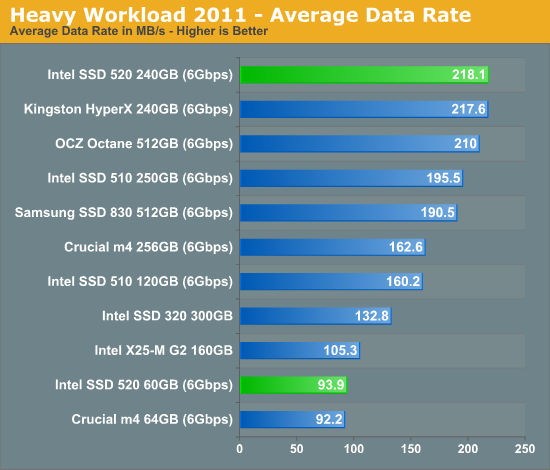
SandForce has always done well in our Heavy Workload test, and the 520 is no different. For heavy multitasking workloads, the 520 is the fastest SSD money can buy. Note that its only hindrance is incompressible write speed, which we do get a hint of in our breakdown of read/write performance below.

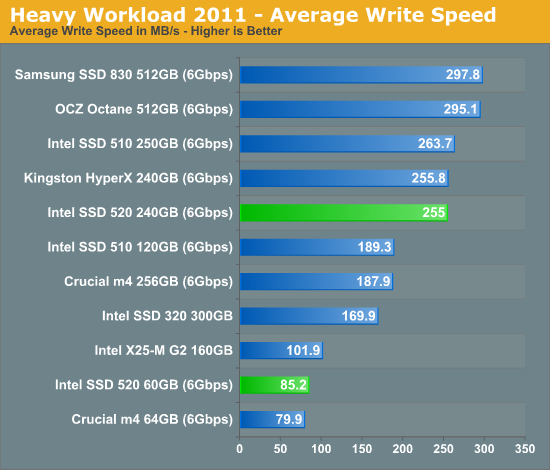
The next three charts just represent the same data, but in a different manner. Instead of looking at average data rate, we're looking at how long the disk was busy for during this entire test. Note that disk busy time excludes any and all idles, this is just how long the SSD was busy doing something:
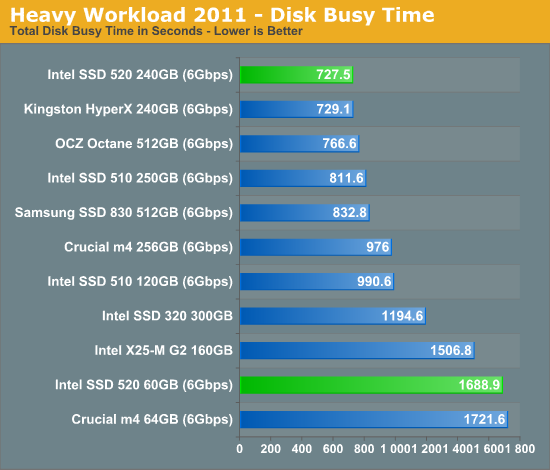
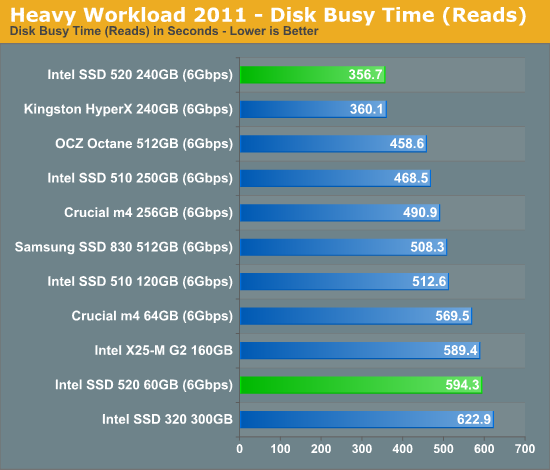
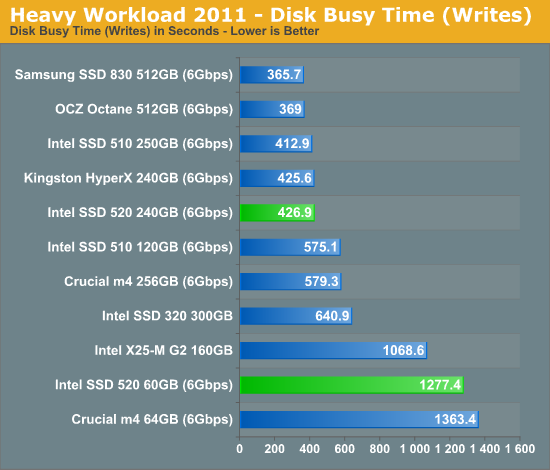










138 Comments
View All Comments
GrizzledYoungMan - Monday, February 6, 2012 - link
Excellent review, Anand. I really appreciate your focus on reliability/compatibility over performance in your latest SSD reviews; that really reflects my own experience in terms of where SSDs need to improve.Do you (or anyone) know when the Intel 520 is scheduled to be available for sale? I didn't notice this information in your article.
Here's hoping it's soon. I am returning a newly purchased Crucial m4 (which has a number of rather absurd semi-known/unacknowledged issues, like stuttering with Intel RST drivers installed, and failing to wake up from sleep) and seeking to replace it with an Intel drive. After owning OCZ and Crucial, I am really looking forward to not having to extensively modify my system just to get things working.
GrizzledYoungMan - Monday, February 6, 2012 - link
This just came up on Amazon: http://www.amazon.com/Intel-SSDSC2CW120A3K5-2-5-In...Price looks right, and is sold by Amazon directly. Can anyone confirm that this model number is correct?
ckryan - Monday, February 6, 2012 - link
Cherryville has been selling in small quantities for weeks now. Benches and pics have been out there. I thoroughly enjoy every one of Anand's SSD reviews as it's never just a review of the drive, but in this case the 520's performance profile has been established well in advance of NDA expiration.Intel's reliability is well deserved IMHO. For those of us wishing against hope for Intel's 10 channel 6gbps controller, keep hoping. As late as 60 days ago, I was hoping that the 520 would utilize the Marvell controller, but when Cherryville started shipping a few weeks back, all hope was lost. And it was pretty obvious when the specs were leaked months and months ago.
Intel's own controller is not fast by the standards of today, but Intel really got to the heart of the matter with the first and second gen drives, which is speed is superfluous without reliability.
SandForce drives have been tamed to a large extent with the 3.3.2FW, but I'm unconvinced of their long term reliability -- the nDurance chart literature reproduced in the article is not realistic in any way, and in my experience SF drives tend to lose in endurance compared to it's competitors. I still own and use SF drives, but when I need reliability over speed, SF is not the way I personally choose to go.
I respect Intel's decision to go SF, and in it's entirely likely that no drive has received the internal scrutiny that the 520 has -- and I'm sure it will pay dividends. But I won't be selling my older Intel drives on eBay anytime soon.
GrizzledYoungMan - Monday, February 6, 2012 - link
Good comment, and useful thoughts, thank you.Since you seem to have a lot of experience with these devices, and similar priorities as me, which would you pick for the system disk of a workstation: the 320 or the 520, both at 120GB? I'm on a p55 mobo with a 3gb/s SATA controller, FYI.
While the performance of the 520 series is attractive, I'm still inclined to believe that I wouldn't notice the real world difference between the two. In which case the 320 series wins on demonstrated reliability.
ckryan - Monday, February 6, 2012 - link
The 320 has a great record -- it's one reliability fault was the rare 8MB error, since corrected. Firmware is so crucial with SSDs, and the actual act of updating FW can cause issues of it's own (ala the Samsung 830, another excellent drive).On a 3gbps Intel mobo port you won't get the sequential speeds, but you will get the good random performance and the 520 handily bests it's fore-bearers in that area.
So I suppose that the issue of price should be considered. The 120GB 320 and 520 are going to be nearly the same price -- so you'd be getting more with the 520. I would say if you're comfortable with it, get the 520.
Regardless of whether SSD or HDD, you should be in a position that if the drive dies 20 minutes from now, restoring your data to it shouldn't be a problem. With that in mind, you can probably bet that the 520 will hold out for it's 5 year warranty. If it doesn't, you still have a 5 year warranty.
As an aside, I recently bought a 320 series 120GB just to have on hand should the need arise, and it is pretty magnificent. I think most people would be just as happy with a 320 than a faster 520 -- the people who crave speed are going to get the fastest drive anyway, so for everybody else the 320 series is still a viable option.
Roland00Address - Monday, February 6, 2012 - link
The 80gb intel 320 has routinely been on sale for the last month from several different online retailers. The sales involve mail in rebates but you see final MIR prices being between 70 to 90 dollars for the 80gb.The 120gb intel 320 on the other hand hasn't really gone on sale in Janurary, only time it went on sale in the last few months was a black friday sale (and BF is not a normal thing.)
GrizzledYoungMan - Tuesday, February 7, 2012 - link
Just bought a 120gb Intel 320 series SSD for $182.00 - nearly $1.50 a gig. Not bad.Between the reliability (both in terms of software, architecture, and power loss protection) and the insane IO performance on reads at lower queue depths, I feel confident I made the right choice.
alpha754293 - Monday, February 6, 2012 - link
Reading this, I'm tempted to buy the 180 GB version because I will be using it in a HPC environment.And if the OCZ Vertex 3 is going to have BSOD issues, I'd rather pay a little bit of a premium or lose a little in storage capacity in order to make sure that the system will be humming along perfectly/nicely.
Such a shame/waste that the Vertex 3s are relegated to being just data drives.
neotiger - Monday, February 6, 2012 - link
It doesn't look like Intel 520 has any capacitors to prevent data loss.So how is this SSD any different from the 5,000 other SandForce SSD's already in the market, except this one is much more expensive than the others?
Sunrise089 - Monday, February 6, 2012 - link
Read the article ;)